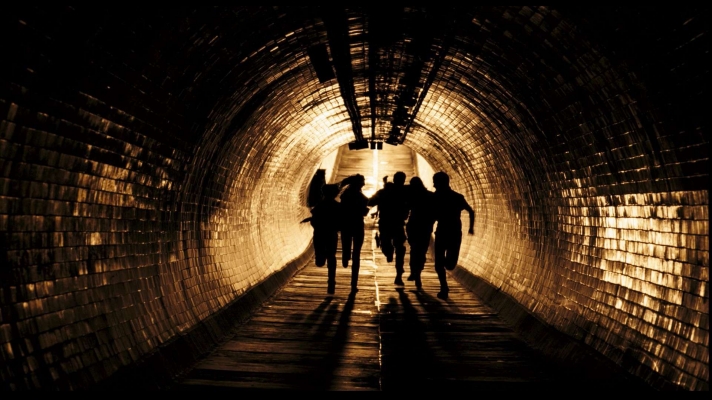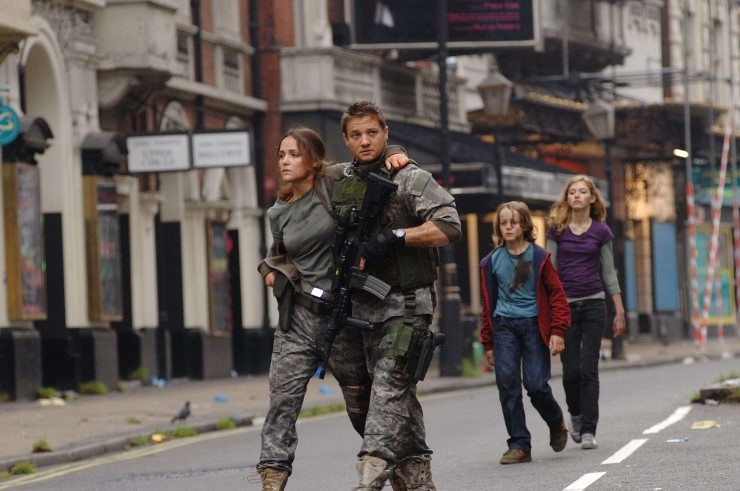28 Weeks Later (2007)
 DIRECTOR: Juan Carlos Fresnadillo
DIRECTOR: Juan Carlos Fresnadillo
CAST: Robert Carlyle, Catherine McCormack, Rose Byrne, Jeremy Renner, Mackintosh Muggleton, Imogen Poots, Harold Perrineau, Idris Elba
REVIEW:
WARNING: THIS REVIEW WILL DISCUSS ELEMENTS OF THE FILM’S PLOT
Another day in the film industry, another superfluous and uninspired sequel…28 Days Later was one of the most frightening movies of 2003 (or any other year), but while tension-packed and involving, it wasn’t a movie that especially cried out for a sequel, and like most unessential sequels, 28 Weeks Later fails to justify its existence, regurgitating more generic retreads of the first movie’s chills and action while lacking its strengths.
As the title suggests, the main action takes place 28 weeks after the events of the first movie, but we open with a prologue set during the initial plague, as a farmhouse sheltering a group of survivors is overrun by a horde of infected. One man, Don (Robert Carlyle), abandons his wife Alice (Catherine McCormack), leaving her to her apparent death while he makes a desperate run for it. 28 weeks later, with the infected having died off, Britain is beginning the process of clean-up, resettlement, and repopulation. With an American-led NATO military force based in London, the first shipments of evacuees are returning home, among them Don and Alice’s children Tammy (Imogen Poots) and Andy (Mackintosh Muggleton), who were fortuitously in Spain when the initial outbreak happened. Don has managed to survive as well, and is reunited with his children (though he is not entirely honest in his version of what happened to Mom). But the seeming safety is short-lived. Against all odds, Alice is discovered alive, but while somehow immune to symptoms herself, she is a carrier, obliviously capable of infecting others through blood or saliva. It’s not long before the virus is again unleashed, and when the military is unable to rein in the outbreak, they turn to the final solution: Code Red.
 Not bringing back any of the surviving characters from the first movie might have been forgivable if the filmmakers had replaced them with anyone worth rooting for. The kids are generic and the adults, even the ones played by recognizable faces, are underdeveloped. Robert Carlyle and Catherine McCormack don’t get much to do apart from the opening scenes, and Idris Elba, as the token stern military commander, is relegated to staring grimly at monitors and issuing Code Red. Rose Byrne (as a military doctor who thinks Alice and her children may contain a genetic immunity making them incredibly valuable) and Jeremy Renner (as a sniper who abandons his post and hits the pavement trying to lead the survivors to safety before his superiors burn London to the ground) get more screentime but never achieve much depth or personality. No one comes close to being an equal replacement to Cillian Murphy, Naomie Harris, or Brendan Gleeson in the first film, whose characters were better-developed and more sympathetic. When main characters die here, we don’t feel much, because we don’t really care about anyone, and that’s a significant factor in 28 Weeks Later being less gripping.
Not bringing back any of the surviving characters from the first movie might have been forgivable if the filmmakers had replaced them with anyone worth rooting for. The kids are generic and the adults, even the ones played by recognizable faces, are underdeveloped. Robert Carlyle and Catherine McCormack don’t get much to do apart from the opening scenes, and Idris Elba, as the token stern military commander, is relegated to staring grimly at monitors and issuing Code Red. Rose Byrne (as a military doctor who thinks Alice and her children may contain a genetic immunity making them incredibly valuable) and Jeremy Renner (as a sniper who abandons his post and hits the pavement trying to lead the survivors to safety before his superiors burn London to the ground) get more screentime but never achieve much depth or personality. No one comes close to being an equal replacement to Cillian Murphy, Naomie Harris, or Brendan Gleeson in the first film, whose characters were better-developed and more sympathetic. When main characters die here, we don’t feel much, because we don’t really care about anyone, and that’s a significant factor in 28 Weeks Later being less gripping.
Another factor is that Danny Boyle has scaled back to merely producing, replaced in the director’s chair by Juan Carlos Fresnadillo, who has gone to the Paul Greengrass school of directing action sequences, where their idea of generating intensity is by violently shaking the camera back-and-forth in all directions and never letting a single shot last for more than a second, turning the action into chaotic blurs where it’s hard to follow what’s happening. At least two potentially exciting action sequences—one in which a crowd of refugees, locked in an underground garage with the lights out is being infiltrated by infected, and the subsequent breakout in which Jeremy Renner’s sniper struggles to pick out infecteds from the hordes of running people—are hampered by our difficulty following what’s going on. No moment here holds a candle to scenes like the underground tunnel and the flat tire in the first movie, and considering the high levels of tension and intensity the first movie achieved and sustained, it’s more than a little underwhelming how comparatively uninvolving the proceedings are here. Fresnadillo deliberately emulates Boyle’s grainy, low-budget, handheld video filming style, and the first film’s musical score is retained, but while working with an expanded budget ($15 million versus the first film’s $8 million), a couple moments of “big-scale” special effects like bomber planes napalming London are unconvincing; the first movie used special effects sparingly, and was the better for it. Elements of the “world-building” in the early set-up scenes, as we see NATO and the returning evacuees beginning the task of resettling and repopulating the abandoned, desolate London, are interesting, but this quickly gets shuffled aside for a lot of generic running around. The concept of Alice and Andy being immune carriers could hold potential for a follow-up plotline, but here it’s merely a sort of MacGuffin. I also take issue with SPOILER WARNING the behavior of Robert Carlyle’s Don post-infection, as he relentlessly follows his children, takes cover during the napalming, and bludgeons a character to death with a rifle butt, all of which makes him seem too human and lacking the zombie-esque mindlessness of the other infected. If this was an attempt to provide us with a kinda sorta “villain” to focus on other than a purely human antagonist like Christopher Eccleston’s Major West from the first movie or endless hordes of interchangeable infected, it feels mishandled.
At the bottom line, like many uninspired sequels, 28 Weeks Later apes the look and style of its predecessor but without recapturing the spark. Fans of the first movie are likely to be underwhelmed, and it doesn’t represent a compelling reason to return to this “world”.
* * 1/2